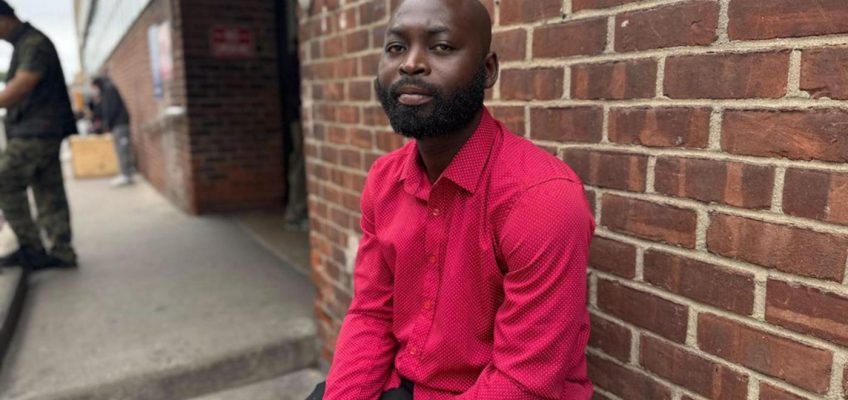By Shalina Chatlani, Stateline.org
NEW YORK — After a year in the U.S. Navy, Loceny Kamara said he was discharged in 2023, because while on base he had developed mental health issues, including severe anxiety and nightmares, and had fallen into alcoholism.
Kamara, 23, went to rehab and managed to get sober for some time while living with family in the Bronx, he said. But after he lost his job as a security guard in December, Kamara was kicked out of his home. Now he lives at a veterans homeless shelter in Long Island City, a neighborhood in Queens, New York, and he relies on the Supplemental Nutrition Assistance Program — commonly known as food stamps — and odd jobs to make ends meet.
Each month, nearly 42 million people receive SNAP benefits to help supplement their grocery budgets. Able-bodied SNAP recipients who are between 18 and 54 and don’t have children have always been required to work. Veterans, however, have been exempt from those rules — but that’s about to change.
The giant domestic policy measure that President Donald Trump signed on July 4 eliminates that exemption. Beginning in 2026, veterans will have to prove they are working, volunteering, participating in job training, or looking for work for at least 80 hours a month to keep their food stamps beyond three months, unless they qualify for another exemption, such as having certain disabilities.
Republicans in Congress and conservatives who helped formulate the law say these eligibility changes are necessary to stop people who could be working from abusing the system. But critics say the change fails to take into account the barriers many veterans face, and that the new work rules will cause thousands of veterans to go hungry.
“I’m pissed. I mean, I cannot get a job. Nowhere to live,” said Kamara. As he spoke, Kamara pointed to his collared shirt, noting that he had just dressed up to interview for a job as a security guard. He learned that morning he hadn’t gotten the job.
“I’ve been out of work for eight months,” Kamara told Stateline. “It’s hard to get a job right now for everybody.”
Veterans depend on SNAP
Nationally, around 1.2 million veterans with lower incomes, or about 8% of the total veteran population of 16.2 million, rely on food stamps for themselves and their families, according to the Center on Budget and Policy Priorities, a left-leaning research group.
An analysis by the group found veterans tend to have lower rates of employment because they are more likely to have health conditions, such as traumatic brain injuries, that make it difficult for them to work. They also tend to have less formal education, though many have specialized skills from their time in the military.
There has been a work requirement for most SNAP recipients since 1996. But Robert Rector, a senior research fellow at The Heritage Foundation, a conservative think tank, said the rules have “never really been enforced.” Rector argued that able-bodied people who have been exempt from the work requirement, such as veterans and homeless people, create an unnecessary burden on the system if they are capable of working but don’t.
“Most of the people that are in this category live in households with other people that have incomes, and so there really isn’t a chronic food shortage here,” Rector said in an interview. “We have tens of thousands of free food banks that people can go to. So it’s just a requirement to nudge these people in the proper direction, and it should no longer go unenforced.”
Darryl Chavis, 62, said that view ignores the difficulties that many veterans face. When Chavis left the U.S. Army at 21 after two years of service, he said, he was “severely depressed.”
“Nobody even came to help me,” said Chavis, who served as a watercraft operator, responsible for operating and maintaining tugboats, barges and other landing craft.
Darryl Chavis, 62, served in the U.S. Army for two years as a watercraft operator. He stands outside the Borden Avenue Veterans Residence, a short-term housing facility in the Long Island City neighborhood of Queens, N.Y., where he lives. Chavis relies on the Supplemental Nutrition Assistance Program and is worried about new work requirements for the program. (Shalina Chatlani/Stateline/TNS)
Chavis said he was diagnosed with post-traumatic stress disorder, which has made it difficult for him to keep a job. He just moved back to New York from Virginia after leaving a relationship. He’s been at the housing shelter in Long Island City since January.
“What I’m trying to do is get settled in to, you know, stabilize into an apartment. I have the credentials to get a job. So it’s not like I’m not gonna look for a job. I have to work. I’m in transition, and the obstacles don’t make it easy,” Chavis said.
The new SNAP work rules apply to all able-bodied adults between 55 and 64 who don’t have dependents, and parents with children above the age of 14. Some groups, such as asylum-seekers and refugees, are no longer eligible for the program.
Barbara Guinn, commissioner of the New York State Office of Temporary and Disability Assistance, estimates that around 300,000 New Yorkers could lose SNAP benefits due to work requirements. Of those, around 22,000 are veterans, homeless or aging out of foster care, she said. Almost 3 million New Yorkers relied on SNAP as of March 2025.
Veterans in other states are in a similar situation. In California, an estimated 115,000 veterans receive SNAP benefits, according to a study by the Center on Budget and Policy Priorities. The number is nearly 100,000 in Florida and Texas, and 49,000 in Georgia.
Between 2015 and 2019 about 11% of veterans between the ages of 18 and 64 lived in food insecure households, meaning they had limited or uncertain access to food, according to the U.S. Department of Agriculture, which oversees SNAP.
“We know that SNAP is the best way to help address hunger. It gets benefits directly to individuals,” Guinn said. “There are other ways that people can get assistance if they need it, through food banks or other charitable organizations, but we do not think that those organizations will have the capacity to pick up the needs.”
Related Articles
Even at the grocery store, Texas troopers don’t let Democrats out of sight after walkout
‘Pure partisan advantage’: Trump leverages presidential power to help his party in the 2026 midterms
Immigrants seeking lawful work and citizenship are now subject to ‘anti-Americanism’ screening
Nebraska announces plan for immigration detention center dubbed the ‘Cornhusker Clink’
US appeals court blocks New Mexico’s 7-day waiting period on gun purchases
A greater burden on states
In addition to the work rule changes, the new law reduces federal funding for SNAP by about $186 billion through 2034 — a cut of roughly 20%, according to the Congressional Budget Office, an independent research arm of Congress. The federal government expects the new work requirements to reduce SNAP spending by $69 billion as people who don’t comply are dropped from the rolls.
SNAP has historically been funded by the federal government, with states picking up part of the cost of administering the program. Under the new law, states will have to cover between 5% and 15% of SNAP costs starting in fiscal year 2028, depending on how accurately they distribute benefits to people who are eligible for the program.
“This has been a strategic agenda to dismantle SNAP and to blame states for doing so, because they knew they are making it so incredibly burdensome to run and operate and unaffordable,” said Gina Plata-Nino, SNAP deputy director at the Food Research & Action Center, a poverty and hunger advocacy group.
“States are going to have to cut something, because there’s no surplus. There are no unlimited resources that states may have in order to be able to offset the harm.”
Guinn said New York expects to see a new cost burden of at least $1.4 billion each year. In California, new state costs could total as much as $3.7 billion annually, according to the California Department of Social Services.
Kaitlynne Yancy, director of membership programs at Iraq and Afghanistan Veterans of America, said many veterans with disabilities will not be able to fulfill the work requirements or find resources elsewhere. And it’s unclear whether states will be able to provide their own relief to people who are no longer exempted from work requirements or will be excluded from the program.
“It is a frustrating thing to see, especially for those that have been willing to put everything on the line and sacrifice everything for this country if their country called them to do so,” she said.
Yancy, 35, served in the U.S. Navy from 2010 to 2014. She began to use food stamps and the Medicaid program, the public health insurance program for people with lower incomes, as she navigated life’s challenges. They included going back to school to pursue her bachelor’s degree, becoming a single mother, and a leukemia diagnosis for one of her children. Frequent trips to the hospital made it hard for her to work steadily or attend school for 20 hours each week, she said.
Guinn said the new rules will create significant administrative challenges, too; even SNAP recipients who are working will struggle to prove it.
“Maybe they’re working one month, they have a job, and then their employer cuts their hours the next month,” Guinn told Stateline. “There are mechanisms for people to upload documentation as needed to demonstrate compliance with the program, but from an administrative standpoint, right now, we don’t have any super-high-tech automated way of doing this.”
©2025 States Newsroom. Visit at stateline.org. Distributed by Tribune Content Agency, LLC.




